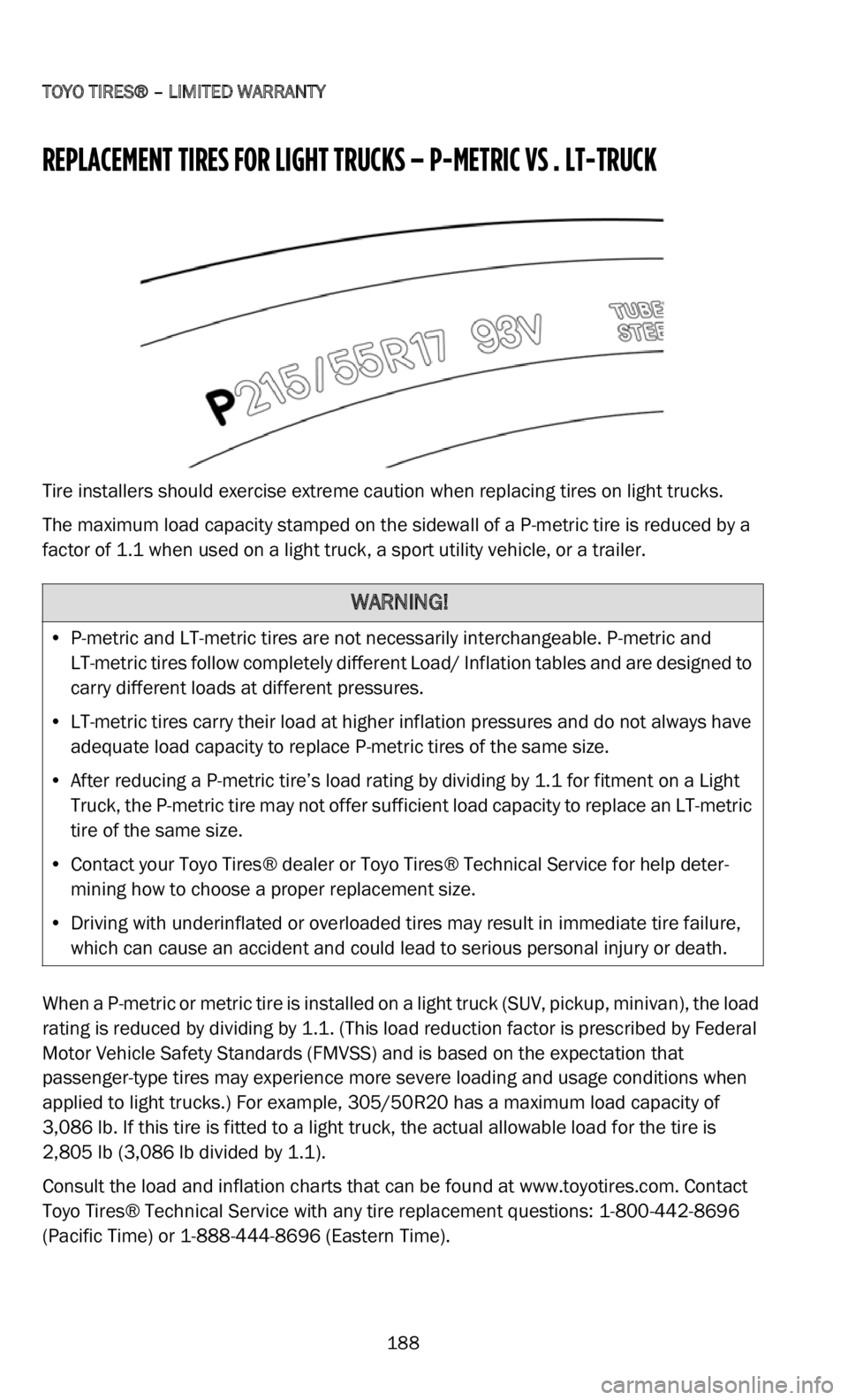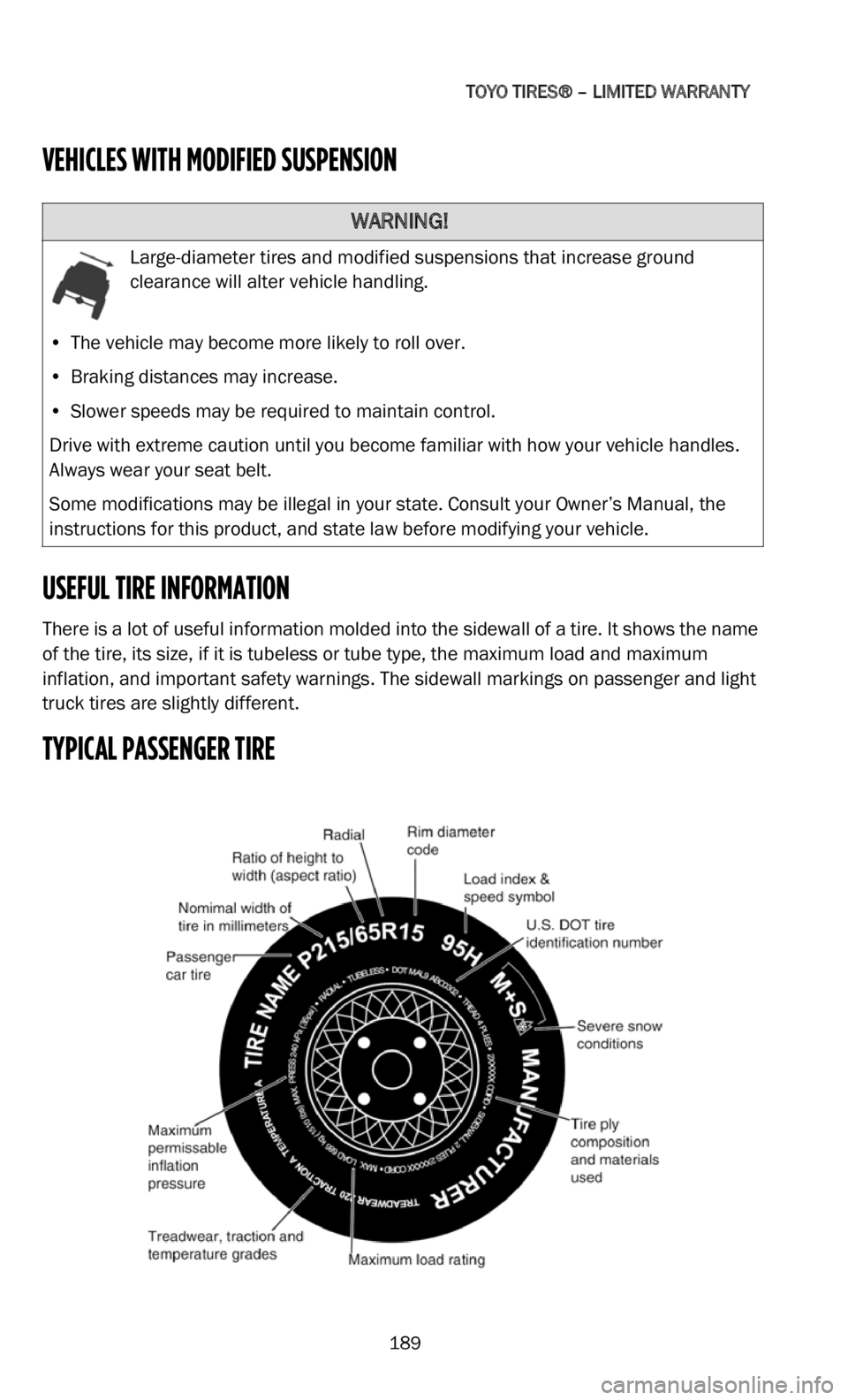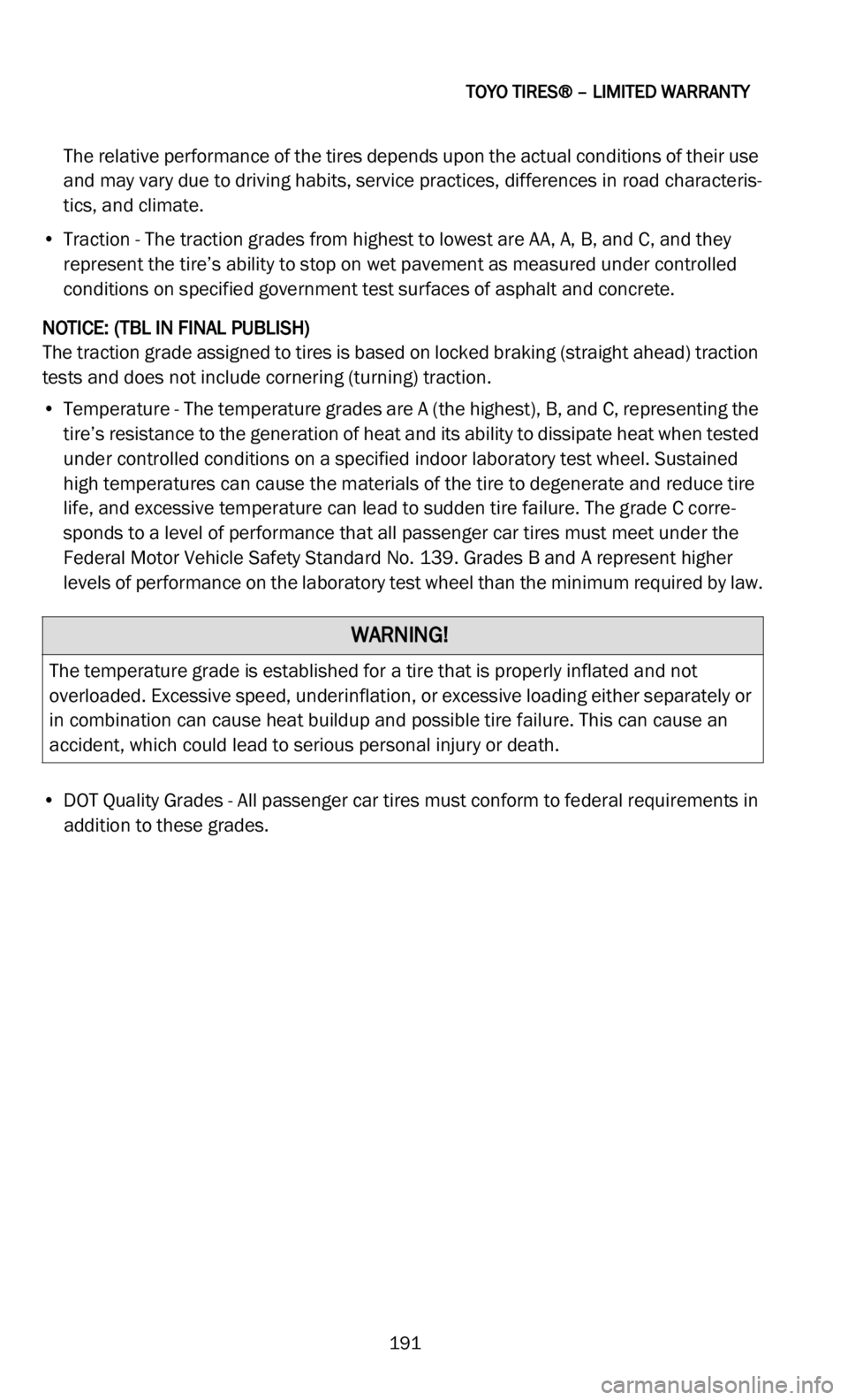warning DODGE DURANGO 2022 Vehicle Warranty
[x] Cancel search | Manufacturer: DODGE, Model Year: 2022, Model line: DURANGO, Model: DODGE DURANGO 2022Pages: 200, PDF Size: 6.72 MB
Page 187 of 200

TOYO TIRES® – LIMITED WARRANTY
186
• When you replace the temporary tire, replace it only with the same type of tire.
• A full-size spare tire in your vehicle is intended for use as a spare when needed. Please
s
ee the “Tire Rotation” section for the proper procedures for including the same size
construction and speed-rated tire (for LT tires of the same size, type, and load rating)
in the rotation pattern. Do not rotate a temporary spare tire.
TIRE STORAGE
Tires should be stored indoors in a cool dry place where water cannot collect inside the
tires. The tires should be placed away from harmful ozone-producing electric generators
and motors and sources of heat such as hot pipes. Storage surfaces should be clean and
free of grease, gasoline, or other substances, which can deteriorate the rubber.
COMPETITION TIRE STORAGE
The rubber compounds used in these tires have unique properties that, when compared
to other tires, can cause them to lose some of their flexibility when used or handled in
conditions below 15° F (-9° C). This loss in flexibility can lead to potential cracking and
other damage to the tire. To minimize the chances of this happening, you are advised to
follow these instructions:
1. Do not move or operate the car with these tires in conditions below 15° F (-9° C).
2
. A void moving these tires in conditions below 15° F (-9° C).
3
. B efore mounting and dismounting, store these tires for at least 24 hours in a
t
emperature-controlled environment of 68° F (20° C) or warmer.
WARNING!
• Check inflation pressure before using your spare tire. Failure to have proper inflation pressure when using your spare tire may cause loss of vehicle control, which could
result in serious personal injury or death. Maintain spare tire inflation pressures
based on the vehicle Owner’s Manual or the Tire Information Placard.
• “ T” Type high-pressure temporary spare tires should not be used with any other
w
heel, nor should standard tires, snow tires, wheel covers, or trim rings be used on
the high-pressure spare tire wheel. If you fail to follow this warning, your vehicle’s
handling characteristics can be seriously affected. You could have an accident
resulting in serious personal injury or death. Consult your vehicle Owner’s Manual for
the proper use of your “temporary use” spare tire.
• D o not operate your vehicle with more than one temporary spare in use (this does
n
ot apply to a full size spare), and only operate it at limited speeds and distances as
indicated on the sidewall of the tire.
• T he “T” Type temporary spare tire may lower ground clearance when used. Avoid
d
riving over large obstacles and other road hazards. Check your vehicle Owner’s
Manual for other special clearance precautions when using the “T” Type temporary
spare tire provided in your vehicle.
Page 188 of 200

TOYO TIRES® – LIMITED WARRANTY
187
4. Remove these tires from the vehicle and deflate to half the normal air-pressure during prolonged periods of non-use or storage.
Always inspect tires for signs of cracking and never use tires that have cracked.
SPECIAL ADVICE FOR LIGHT TRUCKS
Never exceed the speed limit as indicated by the speed symbol on the tire’s sidewall. See
the chart and explanation of speed ratings in this manual.
If you do not know the speed rating of your Toyo brand tire, contact your Toyo Tires®
d e
aler or Toyo Tire U.S.A. Corp. for current information.
TIRES DESIGNATED AS “LT” WITH NO SPEED RATING INDICATED ON THE SIDEWALL
It is not recommended that any light truck be operated at speeds in excess of legal limits.
However, if it is anticipated that sustained driving at speeds in excess of 65 mph may be
r e
quired, then the following adjustments or recommendations should be followed:
• A t speeds from 66 m
ph through 75 mph, cold inflation pressure must be increased
10 psi above the recommended pressures for the load being carried.
• D o not exceed the maximum inflation pressure of the wheel (all wheels have
m
aximum allowable inflation pressures).
WARNING!
Improper storage can damage your tires in ways that may not be visible and could lead
to serious personal injury or death.
Page 189 of 200

TOYO TIRES® – LIMITED WARRANTY
188
REPLACEMENT TIRES FOR LIGHT TRUCKS – P-METRIC VS . LT-TRUCK
Tire installers should exercise extreme caution when replacing tires on light trucks.
The maximum load capacity stamped on the sidewall of a P-metric tire is reduced by a
fa
ctor of 1.1 when used on a light truck, a sport utility vehicle, or a trailer.
When a P-metric or metric tire is installed on a light truck (SUV, pickup, minivan), the load
r a
ting is reduced by dividing by 1.1. (This load reduction factor is prescribed by Federal
Motor Vehicle Safety Standards (FMVSS) and is based on the expectation that
passenger-type tires may experience more severe loading and usage conditions when
applied to light trucks.) For example, 305/50R20 has a maximum load capacity of
3,086 lb. If this tire is fitted to a light truck, the actual allowable load for the tire is
2,805 lb (3,086 lb divided by 1.1).
Consult the load and inflation charts that can be found at www.toyotires.com. Contact
Toyo Tires® Technical Service with any tire replacement questions: 1 -
800-442-8696
(Pacific Time) or 1-888-444-8696 (Eastern Time).
WARNING!
• P-metric and LT-metric tires are not necessarily interchangeable. P-metric and LT-metric tires follow completely different Load/ Inflation tables and are designed to
carry different loads at different pressures.
• LT -metric tires carry their load at higher inflation pressures and do not always have
a
dequate load capacity to replace P-metric tires of the same size.
• A fter reducing a P-metric tire’s load rating by dividing by 1.1 for fitment on a Light
T
ruck, the P-metric tire may not offer sufficient load capacity to replace an LT-metric
tire of the same size.
• C ontact your Toyo Tires® dealer or Toyo Tires® Technical Service for help deter -
m
ining how to choose a proper replacement size.
• D riving with underinflated or overloaded tires may result in immediate tire failure,
w
hich can cause an accident and could lead to serious personal injury or death.
Page 190 of 200

TOYO TIRES® – LIMITED WARRANTY
189
VEHICLES WITH MODIFIED SUSPENSION
USEFUL TIRE INFORMATION
There is a lot of useful information molded into the sidewall of a tire. It shows the name
of the tire, its size, if it is tubeless or tube type, the maximum load and maximum
inflation, and important safety warnings. The sidewall markings on passenger and light
truck tires are slightly different.
TYPICAL PASSENGER TIRE
WARNING!
Large-diameter tires and modified suspensions that increase ground
clearance will alter vehicle handling.
• The vehicle may become more likely to roll over.
•
Braking distances may increase.
•
Slower speeds may be required to maintain control.
D
rive with extreme caution until you become familiar with how your vehicle handles.
A lw
ays wear your seat belt.
Some modifications may be illegal in your state. Consult your Owner’s Manual, the
i n
structions for this product, and state law before modifying your vehicle.
Page 192 of 200

TOYO TIRES® – LIMITED WARRANTY
191
The relative performance of the tires depends upon the actual conditions of their use
and may vary due to driving habits, service practices, differences in road characteris -
tics, and climate.
• T raction - The traction grades from highest to lowest are AA, A, B, and C, and they
r
epresent the tire’s ability to stop on wet pavement as measured under controlled
conditions on specified government test surfaces of asphalt and concrete.
NOTICE: (TBL IN FINAL PUBLISH)
The traction grade assigned to tires is based on locked braking (straight ahead) traction
te
sts and does not include cornering (turning) traction.
• T emperature - The temperature grades are A (the highest), B, and C, representing the
t
ire’s resistance to the generation of heat and its ability to dissipate heat when tested
under controlled conditions on a specified indoor laboratory test wheel. Sustained
high temperatures can cause the materials of the tire to degenerate and reduce tire
life, and excessive temperature can lead to sudden tire failure. The grade C corre -
sponds to a level of performance that all passenger car tires must meet under the
F e
deral Motor Vehicle Safety Standard No. 139. Grades B and A represent higher
levels of performance on the laboratory test wheel than the minimum required by law.
• D OT Quality Grades - All passenger car tires must conform to federal requirements in
a
ddition to these grades.
WARNING!
The temperature grade is established for a tire that is properly inflated and not
overloaded. Excessive speed, underinflation, or excessive loading either separately or
in combination can cause heat buildup and possible tire failure. This can cause an
accident, which could lead to serious personal injury or death.